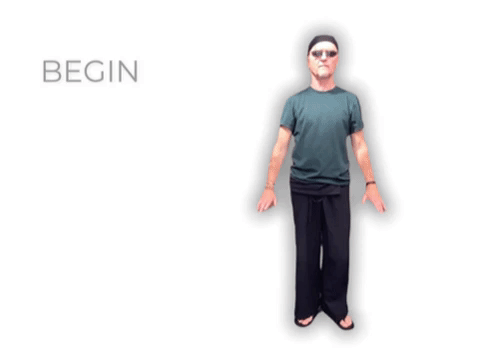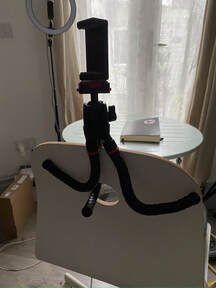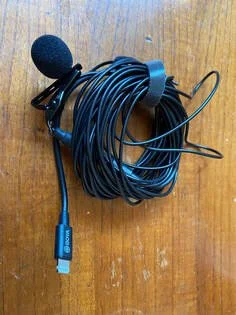TOOLS FOR TEACHING TAI CHI PART ONE: HARDWARE
A 3 part series about online resources, equipment and learning skills for ALL TEACHERS.
Traditionally, Tai Chi teachers would chat about dojo decoration, incense-flavours, hair-cuts or availability of Kung-fu slippers. Nowadays, the emphasis has shifted away from decorative accessories to more technical issues, such as cameras, microphones and green screens. In this 3-part series, the teapotmonk is explores the 3 areas of online resources for teachers of Tai Chi, yoga, movement or martial art practices: Hardware, Software and Distribution Platforms. But first up, let's ask the most obvious question:
Why YOU should be recording Your Tai Chi Practice
There are four good reasons for developing the habit of recording yourself, your practice and your teaching techniques:
In order that you can see yourself. Note: this is not about the ego and instagram uploads, but about self-critical study. Think of it like looking in a mirror to check your posture, alignment and coordination. In these days of cheap cameras, it is an easy and useful way of getting instant self-feedback.
To share with others and record your progress - perhaps a student wants to share his or her progress with their teacher or another practitioner to explain to others what and how they are doing.
Perhaps you are already teaching others and you want to know the best way of using video for capturing your lessons and then sharing that with your students.
Finally, if you are a Tai Chi Academy member (Ninja or above level) you may want to send me a video of your progress for feedback during the monthly recap sessions I organise.
What RECORDING equipment do you need and how much should you pay for it?
Whatever reason you have for recording your progress, start with the equipment you already have using this handy 5-Point Essential Hardware Guide from the teapotmonk
1. HOW TO MAKE USE OF THAT OLD Smart-Phone Camera
Firstly, ask yourself if you really need to purchase an expensive new camera? If you already have a smart phone then the built in camera may well be good enough.
There, I’ve already saved you a fortune. But…you may of course ask: Why not just use the webcam on your laptop?
This may be sufficient for a Zoom call, but not for much else. Some web-cams are obviously better quality than others, but for the most part they are not as good as a phone camera. Even if you have a decent camera built into your laptop, do you really want to be trying to balance your laptop on a fence or a wall to get the right height and angle? And I defy anyone to be able to fix a laptop to a tripod. There are better alternatives...
USING AN OLD CAMERA PHONE
I used an iPhone 5s. (See images below) to create 2 complete Tai Chi courses - the Beginners Tai Chi Sword and the Complete Tai Chi Course. I've no great affiliation with Apple, so don't think you need to get one of their devices. Most smartphones have good enough cameras these days. I'm just pointing out that the iPhone 5s is now pretty old, but can still do a decent job. The important thing about a camera is quality of build and not just resolution. This is why iPhones tend to still be good cameras even when they reach a ripe old age.
TIP: Obviously resolution is important, but don’t always record yourself at the maximum resolution, some new cameras record TV quality and you will soon fill your phone and hard drive. However, do try to record a minimum of about 1080p or more if you have the space to save the files. Remember you can always reduce file size if need be, but never increase it.
SHOULD YOU USE THE FRONT OR BACK CAMERA?
Though the back camera often has better resolution, the reason you'll want to use the front camera is to make sure you are in the shot. If you use the back camera - you cannot see if you are still in frame so may waste a lot of time and energy recording a wall or a sofa, as unknown to you, you have moved outside the screen area. You could of course get someone to film you and use the back camera, but be prepared to treat them to something nice after.
UPDATE: You can use a second device (other camera or tablet or even smart watch) to monitor your framing whilst using the better resolution of the back camera. Apps like Filmic Pro offer this, as well as the standard Remote Camera function on the Apple watch. (there is probably an Android equivalent)
THE MINIMAL SPEC FOR AN OLD CAMERA
This old 5S camera phone has a back facing camera of 8 megapixels and max recording at 1080p, and although the front facing camera is only 1.2 megapixels and records at only 720p (a laughable stat these days) it can still do a pretty good job and is ideal for sharing with other practitioners or for small classes. You can pick up a 2nd hand iPhone 5s on eBay for about £50 and with it create the sort of imagery, videos and gifs you can see here.
USING AN IPHONE 11
For a more professional use, you would be advised to find something a little newer than the old 5s. I now use an iPhone 11 (now dated as the iPhone 14 is due out this year). I am impressed with the quality of the image - both for photos and video work. It has a wide angle lens, and both the back facing and front facing camera are 12 megapixels - capable of recording at 4K, which is pretty much tv quality image. Watch out recording at the highest quality with these newer phones as your video files can be extremely large in size. (More on this in part 2 of this series). For my latest course online, the Cheng Man-ch'ing 37 Step Course, I've been using the front phone-camera. Watch the video below to see an example of recording quality.
You can pick up an iPhone 11 for about £180 or cheaper 2nd-hand or between 4 to 500 pounds (or cheaper) new on eBay (price is going down all the time)
Most cameras now come with a decent resolution, lighting, audio and a stabilisation to reduce camera shake - but, you may, like me, decide you can always do with an extra hand when recording - and if so you may want to think about a tripod.
2. BUDGET Tripods FOR TEACHING ONLINE
Personally, I find a tripod invaluable. Think of it as an assistant that patiently holds your camera in position, enabling you to check angles and framing and holding the image without the slightest tremble or shake. Before I bought one, I used to just prop up the phone on a table or a chair. Once I used a tripod, there was no turning back. They are generally lightweight, portable and they leave you alone to concentrate on your form. Plus they are stable so you do not have to worry about your camera sliding off the wall and landing face down on a rock.
These days they are made of Aluminium - ultra compact and portable and are priced at about £18 upwards.
Alternative Tripods 1 - The gorilla.
There are two accessories that I use these days that give me greater flexibility with camera angles and movement. The first is a GORILLA or flexible friend that enables you to attach your smart phone to fences, tree branches, gateposts, railings or just to back up as a mini second tripod. You can, even get away without using a tripod and just use one of these portable solutions, but do remember that they stand only inches off the floor, so may not be ideal for that zoom call or live webinar.
I used my gorilla to record all my overhead camera work. You can see an example in my Cheng Man-ch'ing course. See the 8 Reasons Video above.
Check out these prices for gorilla tripods.
Alternative Tripods 2 - the Gimbal
The thing about Tai Chi is that it involves movement. Qigong is not so bad as its pretty static in comparison, or should you be teaching mediation, then you probably won't be tempted by one of these. But with Tai Chi, there is always movement. If you need an example, think of trying to capture wide and extensive tai chi sword moves on a fixed tripod. You need to constantly make adjustment steps - unless - you have a gimbal. This is a new toy, that enables me to move around whilst the tripod rotates as it follows the movement of my face. See these Gimbal prices
3. BUDGET Lighting EQUIPMENT FOR TEACHERS
Lighting, for most people, will be a question of simply opening or drawing the curtains. And that is fine. But in the UK where it rains a lot of the time and the light shifts back and forth 3 hundred times a day, it can be disruptive for your filming. For that reason there are 2 light sources you might want to look at.
THE (INFLUENCER) RING LIGHT
These are the newest boys in town and every Instagram or Youtube "influencer" has one permanently glued to their face. They are light-weight, emit with a blue or yellow light and are easy to set up, very portable and cheap to acquire. See these light prices
However, I’m not convinced they are that good. I find the supports unstable and build quality poor (certainly with the ones I have used) But, they are quick and easy to assemble, and give a decent lighting for head and shoulder shots, but not much good for anything else.
STANDS AND LIGHTS
These are for a more professional use, and vary in prices. They are more customisable and give stronger light and are well built. They enable you to alter and displace shadows by angling the light - but on a downside, they take forever to set up, are far more bulky to carry around (and they generally come in pairs) See these prices for stands . You can pick them up, often bundled with a few backdrops for about £50. Now, Speaking of backdrops....
4. BUDGET Backdrops FOR ONLINE TEACHING
At some point, you will be faced with the problem of having to film inside due to bad weather and then, you are going to search everywhere for a wall that does not have a plug socket or portrait of granny in the middle of your shot. You may of course have a film studio in your house, but most of us don't so need to adapt what we have. And this is where a good backdrop comes in - especially a green screen.
You can Pick one up for about £18 or just chuck up on the wall a green or blue sheet - large jumper, old tent or a roll of fake grass.
WHY USE A GREEN SCREEN?
As you can see from the accompanied gif and image, I use my green screen to later change the background so that the student focuses just on the necessary moves. I think this is a useful technique for helping with focus.
I also do this for colour recognition to separate the different versions of the Form I am teaching - If you are working through my Cheng Man-ch’ing course, you will have noticed that the William Chen variation of the Short Form gets the tan/gold background. Whilst the Cheng Man-ch'ing version gets a range of other colours. Or in the colourful beginners Sword form, each of the four sections is defined by different background colours.
If you do buy a green screen, my advise is get the biggest one you can - as once you begin to move around you’ll see how awkward it can be on a very small backdrop.
You may additionally, want to buy a frame to hang the green screen from - or alternatively just peg it to a wall as a cheaper option.
5. BUDGET Audio FOR TEACHING ONLINE
Other than the camera, audio is probably the next most important addition to your recording - especially if you intend to offer audible commentary or explications as to how to do the moves.
There are two classes of microphones you will need to look at - tabletop and wearable.
Tabletop Microphone
You may be asking yourself why not just use the laptop microphone built-in or your smartphone microphone? Well, it is true that each phone upgrade tends to improve microphone quality, and for many of you that will be good enough. But remember that outside, your voice can easily be lost in the sound of traffic, seagulls or dog barks. The laptop microphone meanwhile is pretty poor (think of the last zoom call you did).
For sit down quality audio for recording or podcasts, I use a Raspberry - its the Blues ultra-portable cousin. Unfortunately, I’m not sure the Raspberry is still available, so I recommend the original Blue version that sells for around £99.
Wearable Microphone
For movement and full body work where I have to stand far away from the camera, then I plug in my 6m cable and lapel mic directly into the phone (that is sitting on the tripod). This gives me plenty of cable to move around, plugs into either laptop or phone (via a lightning port or mini jack) and has a pretty decent quality.
The Blue Raspberry
Good quality and portable microphone for podcasting and recording all audio
A lapel Microphone
This one comes with about 6m of cable, long enough to stand back and perform those kicks in front of the camera.
ESSENTIAL HARDWARE FOR TEACHING ONLINE: A Conclusion
So that concludes part 1 of this mini series. Now, obviously do remember to shop around. I’ve scattered a few links for you though this article as examples, but prices change all the time. If you are working on a real budget - just use your camera-phone for everything - camera, audio, lighting and if need be, balance it on a wall or a table if you want to save money on the tripod.
All this is possible, just take care not to let it fall and be prepared to edit out extraneous sounds. If you want to buy one thing, and you already have a smartphone, then I would suggest the tripod, or maybe a lapel mic. ( I know, that's 2, but hey). They will improve substantially the quality of your endeavours. Also bear in mind that I have not reviewed updated phones. Both Samsung, Apple, etc have newer models out now that can do most of this and a lot more. So check to see what your phone is capable of.
Let me know what you are using and if this has been a useful article.
Next in this series is software in which I will be giving tips on how to edit and create using (mostly) free software: If you liked this - you might want to check out the links mentioned in this article
The webinar on Essential Hardware (for Academy members)














